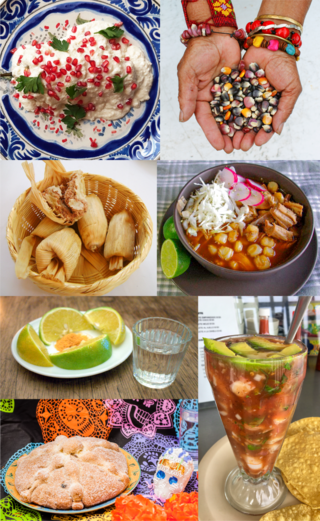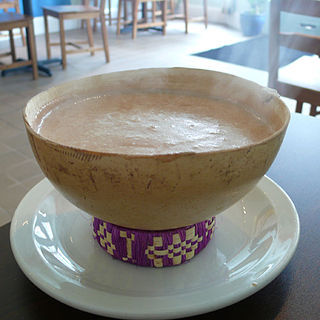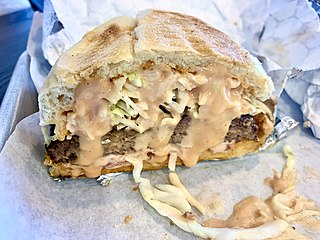
Mexican cuisine consists of the cooking cuisines and traditions of the modern country of Mexico. It's earliest roots lie in Mesoamerican cuisine, but also Iberian Europe. It's ingredients and methods originated with the first agricultural communities such as the Olmec and Maya who domesticated maize, created the standard process of nixtamalization, and established their foodways. Successive waves of other Mesoamerican groups brought with them their cooking methods. These included: the Teotihuacanos, Toltec, Huastec, Zapotec, Mixtec, Otomi, Purépecha, Totonac, Mazatec, Mazahua, and Nahua. With the Mexica formation of the multi-ethnic Triple Alliance, culinary foodways became infused.

Hot chocolate, also known as hot cocoa or drinking chocolate, is a heated drink consisting of shaved or melted chocolate or cocoa powder, heated milk or water, and usually a sweetener. It is often garnished with whipped cream or marshmallows. Hot chocolate made with melted chocolate is sometimes called drinking chocolate, characterized by less sweetness and a thicker consistency.

Atole, also known as atolli and atol de elote. However, it is also believed to come from Mayan origin. It is a traditional hot corn- and masa-based beverage of Mexican origin. Atole can have different flavors added such as vanilla, cinnamon, and guava. Chocolate atole is known as champurrado or atole. It typically accompanies tamales and is very popular during Day of the Dead and Las Posadas.

Champurrado is a chocolate-based atole, a warm and thick Mexican beverage. It is prepared with either a masa , masa harina, or corn flour ; piloncillo; water or milk; and occasionally containing cinnamon, anise seed, or vanilla. Ground nuts, orange zest, and egg can also be added to thicken and enrich the drink. Atole drinks are whipped up using a wooden whisk called a molinillo. The whisk is rolled between the palms of the hands, then moved back and forth in the mixture, until it is aerated and frothy; a blender may also be used.

Panela or rapadura is an unrefined whole cane sugar, typical of Central and Latin America. It is a solid form of sucrose derived from the boiling and evaporation of sugarcane juice. Panela is known by other names in Latin America, such as chancaca in Chile, Bolivia, and Peru, piloncillo in Mexico. Just like brown sugar, two varieties of piloncillo are available; one is lighter (blanco) and one darker (oscuro). Unrefined, it is commonly used in Mexico, where it has been around for at least 500 years. Made from crushed sugar cane, the juice is collected, boiled, and poured into molds, where it hardens into blocks. Elsewhere in the world, the word jaggery describes a similar foodstuff. Both are considered non-centrifugal cane sugars.

Salvadoran cuisine is a style of cooking derived from the nation of El Salvador. The indigenous foods consist of a mix of Native American cuisine from groups such as the Lenca, Pipil, Maya Poqomam, Maya Chʼortiʼ, Alaguilac, Mixe, and Cacaopera peoples. Many of the dishes are made with maize (corn). There is also heavy use of pork and seafood. Eurasian ingredients were incorporated after the Spanish conquest.

Colombian cuisine is a compound of the culinary traditions of the six main regions within Colombia. Colombian cuisine varies regionally and is particularly influenced by Indigenous Colombian, Spanish, and African cuisines, with slight Arab influence in some regions. Furthermore, being one of the most biodiverse countries in the world, Colombia has one of the widest variety of available ingredients depending on the region.

Champús is a drink popular in Ecuador, Perú and southwest Colombia, made with maize, fruits such as lulo, pineapple, quince or guanábana, sweetened with panela and seasoned with cinnamon, cloves and orange tree leaves.

Dominican cuisine is made up of Spanish, indigenous Taíno, Middle Eastern and African influences.

Tejate[teˈxate] is a non-alcoholic maize and cacao beverage traditionally made in Oaxaca, Mexico, originating from pre-Hispanic times. It remains very popular among the indigenous Mixtec and Zapotec peoples, especially in rural areas. It is also very popular in Oaxaca and the surrounding regions. Principal ingredients include toasted maize, fermented cacao beans, toasted mamey pits (pixtle) and flor de cacao. These are finely ground into a paste. The paste is mixed with water, usually by hand, and when it is ready, the flor de cacao rises to the top to form a pasty foam. It can be served as-is or with some sugar syrup to sweeten it. The drink is served cold.

Chilate is a drink prepared with cocoa, rice, cinnamon and sugar. It is originally from Ayutla de los Libres, Guerrero, México. Chilate is served cold and usually accompanied with buñuelos.

Ecuadorian cuisine is diverse, varying with altitude and associated agricultural conditions. Ecuadorian cuisine is an amalgamation of Spanish, Andean, and Amazonian cuisines and to a lesser degree Italian, Lebanese, African, and Chinese. Beef, chicken, and seafood are popular in the coastal regions, especially ceviche, and are typically served with carbohydrate-rich foods, such as rice accompanied with lentils, pasta, or plantain. In the mountainous regions pork, chicken, beef and cuy are popular and are often served with rice, maize, or potatoes. A popular street food in mountainous regions is hornado, consisting of potatoes served with roasted pig. Some examples of Ecuadorian cuisine in general include patacones, llapingachos, and seco de chivo. A wide variety of fresh fruit is available, particularly at lower altitudes, including granadilla, passionfruit, naranjilla, several types of banana, uvilla, taxo, and tree tomato.

Tejuino is a cold fermented beverage made from corn and popularly consumed in the Mexican states of Jalisco and Chihuahua. Tejuino is usually made from corn dough, the same kind used for tortillas and tamales. The dough is mixed with water and piloncillo and boiled until the liquid is very thick. The liquid is then allowed to ferment very slightly. The resulting drink is generally served cold, with lime juice, a pinch of salt and a scoop of shaved ice or lime sorbet.
Mayordomo or Chocolate Mayordomo is a brand of Mexican chocolate para mesa produced by the company Chocolate Mayordomo De Oaxaca, S. De R.L. De C.V., and based in Oaxaca, Oaxaca, Mexico. The company manufactures mole sauce in addition to table chocolate.

Pozol is the name of both fermented corn dough and the cocoa drink made from it, which has its origins in Pre-Columbian Mesoamerica. The drink is consumed in the south of Mexico in the states of Campeche, Chiapas, and Tabasco. It is a thirst quencher that has also been used to fight diseases. It has also aided indigenous peoples of the Americas as sustenance on long trips across the jungles.

Oaxacan cuisine is a regional cuisine of Mexico, centered on the city of Oaxaca, the capital of the eponymous state located in southern Mexico. Oaxaca is one of Mexico's major gastronomic, historical, and gastro-historical centers whose cuisine is known internationally. Like the rest of Mexican cuisine, Oaxacan food is based on staples such as corn, beans and chile peppers, but there is a great variety of other ingredients and food preparations due to the influence of the state's varied geography and indigenous cultures. Corn and many beans were first cultivated in Oaxaca. Well known features of the cuisine include ingredients such as chocolate, Oaxaca cheese, mezcal and grasshoppers (chapulines) with dishes such as tlayudas, Oaxacan style tamales and seven notable varieties of mole sauce. The cuisine has been praised and promoted by food experts such as Diana Kennedy and Rick Bayless and is part of the state's appeal for tourists.

Pinol or piñol is a traditional hot beverage of Ecuador, made from máchica and panela mixed with spices and combined with liquid, usually milk. The term pinol may also refer to the dry mix itself.

Tsokolate, also spelled chocolate, is a native Filipino thick hot chocolate drink. It is made from tabliya or tablea, tablets of pure ground roasted cacao beans, dissolved in water and milk. Like in Spanish and Mexican versions of hot chocolate, the drink is traditionally made in a tsokolatera and briskly mixed with a wooden baton called the molinillo, causing the drink to be characteristically frothy. Tsokolate is typically sweetened with a bit of muscovado sugar, and has a distinctive grainy texture.




























